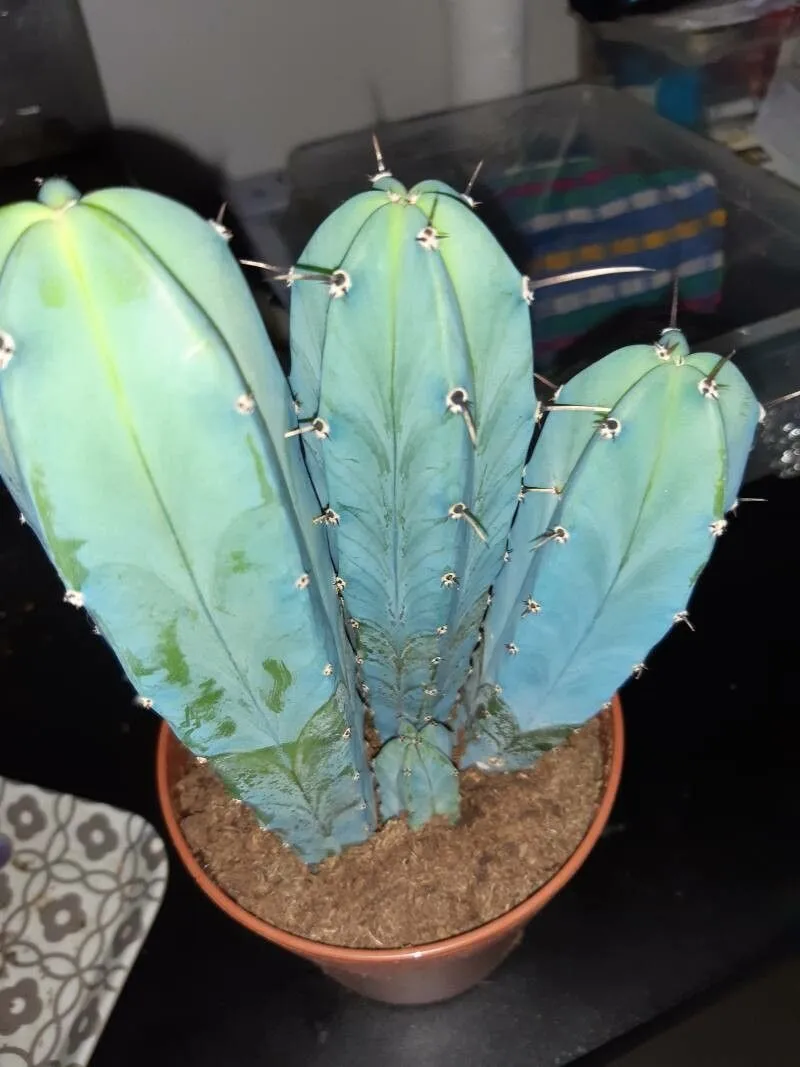
Author: (Mart. ex Pfeiff.) Console
Bibliography: Boll. Reale Orto Bot. Palermo 1: 10 (1897)
Year: 1897
Status: accepted
Rank: species
Genus: Myrtillocactus
Vegetable: False
Observations: Mexico
The Blue myrtle-cactus, scientifically known as Myrtillocactus geometrizans, is a remarkable and visually striking species belonging to the Cactaceae family. Discovered and documented in historical botanical literature, this cactus was first recognized in 1897, as recorded in the prestigious Boll. Reale Orto Bot. Palermo journal.
Originating from Mexico, the Blue myrtle-cactus thrives in the arid and semi-arid regions, showcasing its resilience and adaptability to harsh climates. This plant is particularly notable for its distinct, blue-green stems that create a striking contrast against the natural desert landscape. The stems are coated with a waxy, glaucous layer that not only adds to the plant’s aesthetic appeal but also aids in water retention, a vital feature for survival in its native arid environment.
Myrtillocactus geometrizans is a densely branching cactus, growing either as a solitary columnar structure or developing multiple arms that spread outward. These branches can reach up to four meters in height, making the cactus a prominent feature in its natural habitat. The plant’s geometric form and the well-defined ribs along its stems contribute to its unique architectural presence, which has garnered significant interest among botanists and cactus enthusiasts alike.
Flowering typically occurs in the spring and early summer, when the Blue myrtle-cactus produces small, creamy-white to yellowish flowers. These delicate blossoms are nocturnal, opening in the twilight hours to attract a variety of nocturnal pollinators, including bats and moths. Following pollination, the cactus produces small, edible berries that are often deep purple or black in color, resembling myrtle berries, hence the common name.
The Blue myrtle-cactus has also found a place in horticultural settings beyond its native range. Its striking appearance and ease of care make it a popular choice for xeriscaping and as a potted specimen in cactus collections. It requires minimal water and thrives in well-draining soil, making it an ideal plant for those looking to cultivate a low-maintenance yet visually captivating addition to their garden or indoor plant collection.
Overall, the Blue myrtle-cactus, Myrtillocactus geometrizans, stands out not only for its beauty and structural elegance but also for its ecological importance and adaptability. As a testament to nature’s ingenuity, this cactus continues to capture the fascination of plant lovers and researchers around the world.
Eng: bilberry cactus, blue-flame, our-father, whortleberry cactus
Swe: blåbärskaktus
Por: cactus
Spa: garambullo, padre nuestro
En: Blue Myrtle-Cactus, Bilberry cactus, Blue-flame, Our-father, Whortleberry cactus
Zh: 龍神木
Fi: Sinihärmekaktus
Pt: Cactus
Ru: Миртиллокактус геометрический
Es: Garambullo, Padre nuestro
Sv: Blåbärskaktus
Zh-tw: 龍神木
Taken Oct 28, 2020 by BLETSA Katherine (cc-by-sa)
Taken Nov 29, 2021 by Arno Nymous (cc-by-sa)
Taken Jul 7, 2022 by Andrzej Konstantynowicz (cc-by-sa)
Taken Sep 20, 2022 by Stefan Spoon (cc-by-sa)
Taken Sep 20, 2022 by Stefan Spoon (cc-by-sa)
Taken Feb 6, 2021 by López Sebastián (cc-by-sa)
Taken Feb 6, 2021 by López Sebastián (cc-by-sa)
Taken Nov 23, 2022 by galdeano Blanca (cc-by-sa)
Taken Oct 1, 2019 by Márquez Juan Gabriel (cc-by-sa)
Taken Sep 20, 2022 by Stefan Spoon (cc-by-sa)
Taken Jan 4, 2022 by Trap Hers (cc-by-sa)
Taken Sep 2, 2022 by KP Laer (cc-by-sa)
Taken Sep 6, 2021 by Viktoriya Mazykina (cc-by-sa)
Taken Sep 5, 2020 by Bozhena Mihaylova (cc-by-sa)
Taken Sep 6, 2021 by Viktoriya Mazykina (cc-by-sa)
Taken Sep 19, 2020 by Govea Ale (cc-by-sa)
Taken Oct 7, 2022 by Stephanie Riesco (cc-by-sa)
Taken Apr 13, 2022 by Emmanuelle Bulens (cc-by-sa)
Taken Jul 25, 2020 by Heredia Carrasco Xanatu (cc-by-sa)
Taken Jan 1, 2011 by Vargas Carlos (cc-by-sa)
Taken Apr 10, 2017 by franz (cc-by-sa)
Taken Dec 9, 2020 by Jarquin Raúl (cc-by-sa)
Taken Dec 9, 2020 by Jarquin Raúl (cc-by-sa)
Taken Apr 12, 2022 by Javier Cervantes (cc-by-sa)
© copyright of the Board of Trustees of the Royal Botanic Gardens, Kew.
© copyright of the Board of Trustees of the Royal Botanic Gardens, Kew.
© copyright of the Board of Trustees of the Royal Botanic Gardens, Kew.
Family: Myrtaceae Author: (F.Muell.) K.D.Hill & L.A.S.Johnson Bibliography: Telopea 6: 402 (1995) Year: 1995 Status:…
Family: Rubiaceae Author: Pierre ex A.Froehner Bibliography: Notizbl. Bot. Gart. Berlin-Dahlem 1: 237 (1897) Year:…
Family: Sapindaceae Author: Koidz. Bibliography: J. Coll. Sci. Imp. Univ. Tokyo 32(1): 38 (1911) Year:…
Family: Asteraceae Author: A.Gray Bibliography: Pacif. Railr. Rep.: 107 (1857) Year: 1857 Status: accepted Rank:…
Family: Fabaceae Author: Medik. Bibliography: Vorles. Churpfälz. Phys.-Ökon. Ges. 2: 398 (1787) Year: 1787 Status:…
Family: Aspleniaceae Author: (Cav.) Alston Bibliography: Bull. Misc. Inform. Kew 1932: 309 (1932) Year: 1932…